Inca Terrace Farming And Aztec Floating Gardens
/https://tf-cmsv2-smithsonianmag-media.s3.amazonaws.com/filer/Inca-farming-huana-harvest-631.jpg)
The Andes are some of the tallest, starkest mountains in the world. Yet the Incas, and the civilizations before them, coaxed harvests from the Andes' sharp slopes and intermittent waterways. They developed resilient breeds of crops such as potatoes, quinoa and corn. They built cisterns and irrigation canals that snaked and angled down and around the mountains. And they cut terraces into the hillsides, progressively steeper, from the valleys up the slopes. At the Incan civilization's height in the 1400s, the system of terraces covered about a million hectares throughout Peru and fed the vast empire.
Over the centuries, cisterns fell into disrepair, canal beds dried up and terraces were abandoned. This process began when the Spanish imposed their own crops and forced people off traditional lands to farm and mine for the conquistadors. The local populations were devastated by war and, more significantly, by disease. Some researchers estimate that as many as half of the Incan population died soon after the Spanish conquest. Much of the traditional farming knowledge and engineering expertise was lost.
The ghost of the Incas' farming achievements still shadows the Andes. The remnants of ancient terraces appear as lines of green on the mountains. Former irrigation canals carve hollows into the land. Today, in a corner of the Andes, people are breathing new life into ancient practices. Inspired by recent archaeological research, they are rebuilding terraces and irrigation systems and reclaiming traditional crops and methods of planting. They do this in part because Incan agricultural techniques are more productive and more efficient in terms of water use. But these modern farmers also believe the Incan ways can offer simple solutions to help protect communities' food supply in the face of climate change.
Archaeologist Ann Kendall began studying terraces in the Cuzco region of Peru in 1968. She intended to focus on Incan architecture and stonework, but she was soon captivated by the dry canal beds and terraces that beckoned from across the valley. "I thought about the problem that local people had no water and didn't cultivate this [agricultural system]," she says. She remembers thinking, "if only one could study traditional technology and rehabilitate all this in the Andes, wouldn't it be wonderful."
She decided to study the development and technology of the Incan agricultural systems with the idea of rehabilitating them. Over the years, she learned how the Incan builders employed stones of different heights, widths and angles to create the best structures and water retention and drainage systems, and how they filled the terraces with dirt, gravel and sand.
In the 1600s, Garcilaso de la Vega, the child of a conquistador father and an Incan noblewoman, described the Incan terracing system in The Royal Commentaries of the Incas: "In this way the whole hill was gradually brought under cultivation, the platforms being flattened out like stairs in a staircase, and all the cultivable and irrigable land being put to use."
The terraces leveled the planting area, but they also had several unexpected advantages, Kendall discovered. The stone retaining walls heat up during the day and slowly release that heat to the soil as temperatures plunge at night, keeping sensitive plant roots warm during the sometimes frosty nights and expanding the growing season. And the terraces are extremely efficient at conserving scarce water from rain or irrigation canals, says Kendall. "We've excavated terraces, for example, six months after they've been irrigated, and they're still damp inside. So if you have drought, they're the best possible mechanism." If the soil weren't mixed with gravel, points out Kendall, "when it rained the water would log inside, and the soil would expand and it would push out the wall." Kendall says that the Incan terraces are even today probably the most sophisticated in the world, as they build on knowledge developed over about 11,000 years of farming in the region.
Over the past three decades, using archaeological details about the construction of terraces and irrigation systems, a development charity called the Cusichaca Trust, which Kendall formed in 1977, rehabilitated and irrigated 160 hectares of terraces and canals in the Patacancha Valley, near Cuzco. The project was a success: it improved water access and agricultural production, and local families maintain the structures today. Lessons from the Patacancha Valley are now being employed to restore Incan agricultural systems in other areas of Peru.
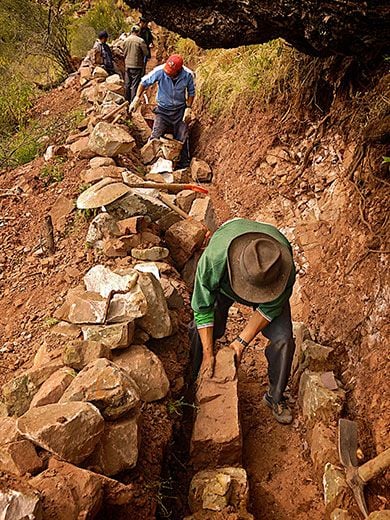
/
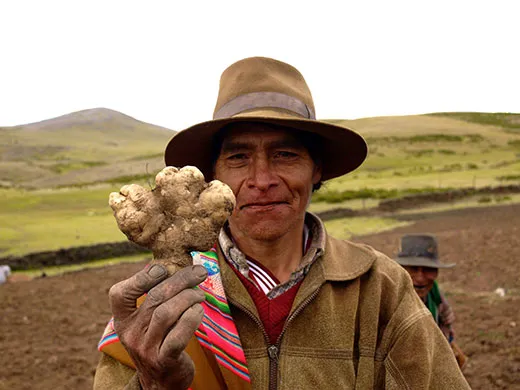
/
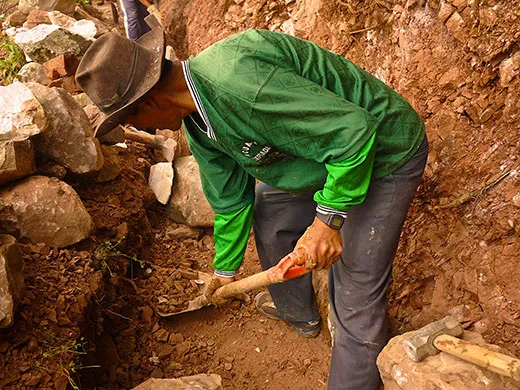
/
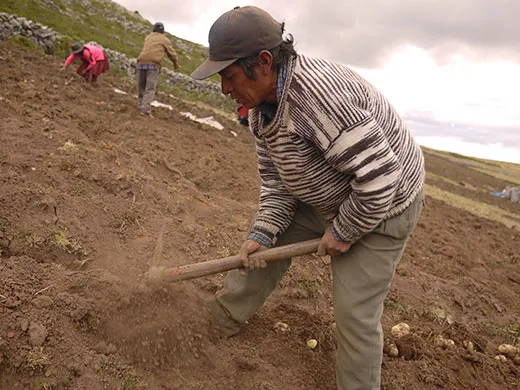
/
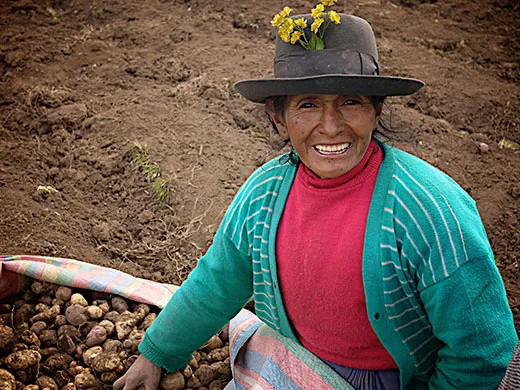
/
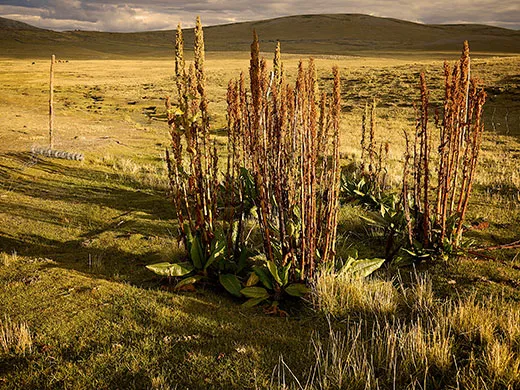
/
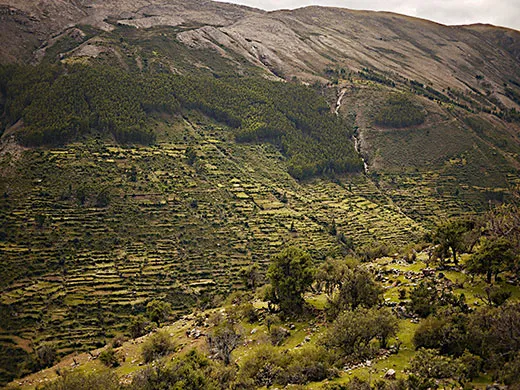
/
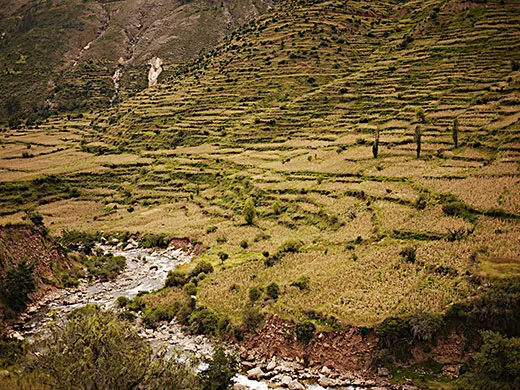
/
The thud of hammer on rock reverberates in a remote valley in the Apurímac region. A worker from a nearby village swings a mallet and chips off the edges from a massive stone that has been hauled into the bed of an ancient irrigation channel. That rock will form one wall of the repaired channel. He and a half-dozen workers have been hard at work for a month already, and have rebuilt about a third of the channel.
The work is part of a two-year project to mitigate the effects of climate change. Kendall and her local partners in Cusichaca Andina (an independent Peruvian nonprofit formed in 2003) began activities in the remote regions of Apurímac and Ayacucho because they wanted to expand past Cusco. The area is blanketed with terraces, most unused for centuries. It also was the center of power for the Sendero Luminoso, or Shining Path, during the 1980s and early 1990s. Many locals fled from the guerrilla fighters, abandoning farms and leaving the area with little farming expertise.
The exact age of this particular channel hasn't been determined, but Adripino Jayo, the regional director of Cusichaca Andina, which leads the restoration with funding from the World Bank, estimates that it's been used to funnel water from a nearby spring perhaps since the time of the Wari, whose civilization spread over the Andes for hundreds of years before the Incan empire.
Trainers from Cusichaca Andina schooled the community on how to repair the canal using local materials, which are cheaper than concrete and avoid the need to import materials from the city. One worker swings a pickax to carve out dirt and then shovels it aside. Another worker lines up stones evenly on the channel's sides. They use local clay to fill the gaps between boulders and alongside the earthen banks. When it hardens, the clay is watertight.
Yellowing stalks of corn, quinoa and amaranth drape over and obscure the stone walls that have already been repaired. From September through December last year, local workers rehabilitated 54 hectares of terraces. By the spring of 2012, the teams hope to rebuild nearly two miles of irrigation channels.
In the few restaurants that can be found in nearby villages, rice trucked in from cities and the coast is on offer more frequently than the local quinoa. Jayo quotes a common city refrain that can keep those in the mountains from celebrating their own bounty: only the poor eat quinoa. In the latter half of the 1900s, as remote mountain towns gained increasing access to radio, television and communication with the cities, local crops fell out of favor.
But local grains are more nutritious and better suited to the Andean land and climate. So Cusichaca Andina has conducted educational training campaigns and given away seeds for quinoa, corn and amaranth. The seeds have been planted over 45 hectares, now used as demonstration sites to highlight how traditional farming practices of planting corn, quinoa and squash together, instead of in individual plots, can yield better results, as the crops symbiotically protect and nourish each other.
The organization has also focused on rescuing seeds and varieties that have been in danger of disappearing, such as huaña, a bitter potato variety that resists hail, frost, droughts and excess rain. After being soaked for days and frozen outdoors overnight to remove the bitterness, the potato is dried and can be stored for years.
Jayo highlights the strength and resistance of this crop: "Now that we're facing the crisis of climate change, it's worth recovering crops such as these." Clemente Utani, the mayor of the nearby town of Pomacocha, focuses on the historic significance of Cusichaca's work, saying, "We're recovering what we lost from our ancestors."
Approaches such as these might be crucial for poor Peruvian farmers. Glacial melt and the seasonal rains, the key suppliers of water, are already affected by climate change. Rains have already shown signs of decreasing, temperature swings have become more extreme and Peru's glaciers have shrunk about 20 percent since the 1970s.
The need for water conservation and agricultural development far outstrips the efforts and the available funding, Jayo says. But the idea does seem to be catching on. The Peruvian Ministry of the Environment, in a recent report to the United Nations Framework on Climate Change, highlighted the importance of practices such as reclaiming diverse native Andean crops and rebuilding the infrastructure of pre-Hispanic irrigation.
"At first people thought I was a bit of a nutter with my terraces," says Kendall with a laugh, "but now this is the word everywhere it seems in Peru." And not only in Peru. The Andes stretch from Venezuela and wind down South America as far as Argentina and Chile. Kendall says some countries have terraces that have been maintained, and groups in Bolivia and elsewhere are expressing interest in learning from Cusichaca's rehabilitation experience.
Mountainous regions around the world have a history of terracing. Kendall spoke at a terracing conference in southern China in 2010. She and 50 experts were taken by bus to view the extensive irrigated rice terraces and meet with farmers. These are not, however, the dry mountain terraces that are Kendall's particular expertise. But through the bus windows, Kendall saw evidence of dry terraces lining the hills and mountainsides, mostly abandoned and covered with vegetation—terraces potentially ripe for rehabilitation.
Recommended Videos
Inca Terrace Farming And Aztec Floating Gardens
Source: https://www.smithsonianmag.com/history/farming-like-the-incas-70263217/
Posted by: burtonwintralmor.blogspot.com

0 Response to "Inca Terrace Farming And Aztec Floating Gardens"
Post a Comment